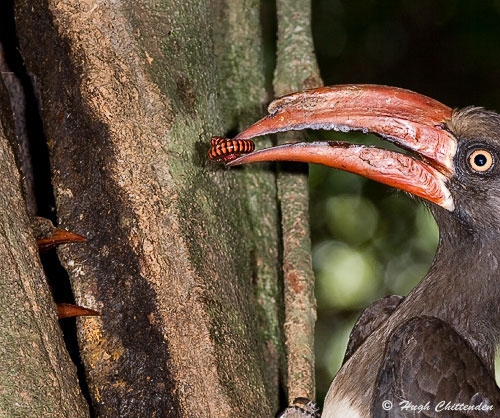Topic : Land Birds
Article 41 ![]() 14 November 2007
14 November 2007
Crowned Hornbill breeding cycle, invertebrate prey – Part 2
Prey brought to nest
At least 95% of the food items brought to this nest during these observations were animal prey, and of these, 85 – 90% were invertebrates. A small percentage of other food included vertebrates and also large fruit items. Fruit intake of African Crowned Hornbills appears to be higher during the winter months (non-breeding season) when animal food is scarce and this species is forced to move to warmer habitats in adjacent low-lying regions. The selection of prey shown in Part 2 of this series reflects the most common invertebrates delivered to the nest during December and January in Dlinza Forest, Eshowe, KwaZulu-Natal.

Both smooth skinned and ‘hairy’ caterpillars were brought to the nest.
Invertebrates
Easily the two most common prey items were locusts and caterpillars. Large numbers of Milkweed Locusts Phymateus spp were delivered and fed to both the female (while she was in the nest) and to the nestlings. These locusts produce a foul smelling foam when handled and human fatalities have been recorded from consuming locusts within this genus!

Foul smelling Green Milkweed Locusts (left) were common prey items and the occasional slug (right) was also delivered to the nest.
Red coloured forest millipedes are not uncommon prey items. This is unusual as most birds to not normally touch millipedes. Perhaps this species of millipede is less toxic than their larger black coloured relatives that birds seem to avoid as a source animal food.

Millipede prey.
Prey was collected by the male both within the forest and on the forest margins. About half way through the nestling period, the female’s flight feathers are sufficiently developed for her to break out the nest and help the male with the demanding task of prey collection. Amazingly, the chicks then re-plaster the nest entrance hole to protect themselves from predation for the final few weeks that they remain in the nest.

A wide range of grasshoppers, including Leaf Katydids are preyed upon.

A Milkweed Locust (above) and Cicada prey below.
